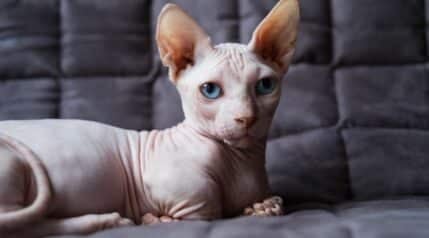When you purchase through links on our site, we may earn a commission. Here’s how it works.
The docile and gentle Persian cat is a popular pet. Also called the Persian Longhair, they are one of the oldest cat breeds known to man. These affectionate, calm kitties stand out for their long, silky coats and calm and gentle nature. They are also unique because they are one of the few flat-faced cat breeds.
The Persian cat is a regal beauty with a reputation for being very docile, making it a fantastic choice for a family pet. Do not let this cat’s quiet personality fool you. They are quite expressive and observant.
There is a lot to know about this silky, pouty-faced breed. Without further ado, let’s get into it and learn what makes the Persian cat so special.
Breed History
The Persian cat is an incredibly old breed whose exact origins are unknown. It is believed to have originated in ancient Mesopotamia and the area once known as Persia, which encompassed the area now known as Iran. These silky cats were first brought to Europe by travelers around 1620 and quickly became popular among the wealthy and upper class. Over time, the Persian cat has been bred into various types, such as the flat-faced “Peke-faced” Persian and the traditional Persian, also called “doll-faced” cats.
Persians are also called Iranian cats, Shirazi, and “smushed-face cats.”
Long-haired felines from the same geographical area, including Turkey, Afghanistan, and Persia, were grouped as one breed for many years. They were called “Asiatic” cats. In the 1870s, selective breeding began to craft the more contemporary Persian breed of today.
Persians were regaled by people worldwide at the very first-ever cat show held at London’s Crystal Palace in 1871. Their breed was recognized by the Cat Fanciers’ Association in 1906. This breed is quite famous, beloved by royalty, and even famous in Hollywood. One notable kitty hit the silver screen as a James Bond cat in 1963, and in the movie “Cats & Dogs” as the ruthless Mr. Tinkles.
Persian kittens were popular among royalty like Britain’s Queen Victoria. They are also a top choice of celebrities of many generations. Marylin Monroe had one as a pet, as does Martha Stewart.
Persian Cat Appearance & Size

Persian kitties have round, larger heads, full cheeks, big, expressive eyes, and rounded ears. Their noses are short and flat. The two most prominent features of this breed are their flowing, glossy coats and flat faces.
This breed’s head is distinguishably large, making their flat faces seem even more prominent. Their eyes can be many colors, often corresponding to coat color. Lighter-colored kitties will have lightly hued blue-green and copper eyes, while darker colors may have green, blue-green, silver, copper, or golden eyes. Their eyes are quite expressive, and they will spend hours observing and watching humans from the safety and comfort of an armchair or secret snuggle spot.
Persians are a medium to large-sized breed, with a weight range of 7 to 12 pounds. They can reach between 14 and 18 inches long, not including tail length. Males are usually slightly larger than females. This kitty is heavy-boned, and with their long flowing coats and larger, distinctive heads, often seem much bigger than they truly are.
Coat Color
Persians have an incredible variety of colors and coat patterns. They come in many different variations of white, black, red, cream, blue, chocolate, lilac, silver, and golden. Additionally, these kitties can be different patterns like calico, tabby, shaded, smoke, and multicolored. Some can have color point patterns, and others are solid-colored.
Persian Cat Personality & Temperament
The Persian cat is quite amiable and known for her docile, sweet personality. She is pleasant-tempered yet reserved and does not worry about what is happening in the outside world. Persians are indoor-only animals with no high prey drive or a huge desire to explore.
These sweet kitties like people, but they do not like everyone. They save their affection and attention for their close human family members. The breed is often called musical because they have a very soft, melody-like meow rather than a loud, annoying yowl.
Persian Cats & Children
Doll faces do well with children if handled gently and carefully. They do not mind being pampered, dressed up, pushed around in a stroller, or played with as long as they get carried softly and treated gently. Persian kitties are very amicable and will tolerate a lot of activity. They tend to be very affectionate with kids and stay gentle but will remove themselves if they feel overwhelmed.
It’s important to teach children how to handle, care for, and interact with their sweet Persian cat carefully. These kitties love interaction but do not like to be roughhoused with, chased, or scared. Gentle handing is key with the Persian cat.
Persian Cats & Other Pets
You will be happy to know that doll-faced cats are agreeable with humans and get along very well with other felines. They also tolerate dogs as long as they are in a relaxed environment. They prefer calm environments, so they may not like it when other animals invade their space.
Shedding
Persians have thick, double coats of fur, making them appear so fluffy and round. Just like any other kitty, they regularly shed, though it may seem like they shed more due to their sheer volume of hair. They shed year-round, though they experience times of heavier shedding that correspond with significant seasonal temperature changes.
You can expect significant shedding all year because these kitties are indoors only. Keeping your home at a consistent temperature is one way to help manage feline shedding.
A commonly asked question is if Persians are hypoallergenic, and the answer is, no, this kitty is not hypoallergenic. They have a lot of hair and produce plenty of the allergy-inducing protein, Fel d 1. Consider a different, more allergy-friendly breed if you are prone to allergies.
Grooming

The Persian is a high-maintenance feline. Along with daily brushing and regular bathing, these kitties will need help with grooming around the genitals and under the tail. Because their hair is so long, along with their stocky bodies and flat faces, it is hard for them to keep these areas clean. You may choose a sanitary shave, or you will need to pay regular attention to this area. Otherwise, it will become a very unpleasant mess quite quickly. The longer-haired variety requires even more attention.
Because they have such long, thick hair, doll faces require daily grooming. This is important to keep their coats clean, prevent mats and knots from forming, and distribute natural oils throughout the coat. This also helps keep your cat’s coat glossy, shiny, and soft and can aid in preventing hairballs.
Grooming Tips For Persian Cats
Keep the following in mind when grooming your Persian kitty.
- You should always inspect your pet’s coat during grooming sessions to make sure there are no cuts, irritations, bald spots, mats, or knots.
- Work any mats or knots out with your fingers before brushing, and trim them off if necessary.
- Start with a comb to pull through any tangles, debris, or mats. A wide-toothed metal comb works well.
- Comb the face gently along the natural grain of the hair. You can try a soft-bristled toothbrush to get around the eyes.
- Try to avoid combing and brushing against the grain. It can cause discomfort and pain.
- You may need clippers for a sanitary shave and clipping your Persian cat’s furry behind.
- Try to bathe your cat about once a month, twice if her fur is on the greasy side.
- You will need to invest in quality grooming supplies and tools. These include a high-quality pin brush, bristle brush, combs, detangling spray, dry shampoo, conditioner, and shampoo. Always make sure to use products that are feline-safe, and never use human products on your pet.
Some purr parents choose to trim their Persian cat’s hair to help control shedding and minimize the need for daily brushing. This is called the “lion cut,” leaving hair around the head, feet, and tail fluffy while the body hair is trimmed shorter.
Care
These purr babies are happy to lounge the day away as long as you provide some toys and access to fresh water and tasty food. They appreciate a cozy spot in the sun to curl up and snooze.
Like any other breed, this kitty needs regular exercise but is not as motivated or as athletic as some other breeds. She will enjoy regular playtime with a laser pointer, a feather toy, catnip treats, and chasing toys. She is more concerned about companionship than high-paced exercise, climbing high, or being adventurous. A couple of sessions of interactive play each day will keep her physically and mentally stimulated.
As with all felines, Persians need regular trips to the veterinarian and should be kept up to date with vaccinations and preventative care. This kitty is prone to some health conditions, so take special care to ensure they do not miss vet appointments.
These purr babies also need you to pay attention to their dental hygiene. Three or four times a week teeth brushing is a good goal. Additionally, you must regularly clip your cat’s nails to prevent injury and damage to the home.
Nutrition

Like all other felines, Persians are obligate carnivores and should eat a diet modeled after a feline’s natural diet. This means they need diets that are meat-heavy and rich in high-quality animal protein. Whole meat, including organs and protein varieties like fish, poultry, and red meat, do best. Persians do better on diets high in meat protein and very low in carbohydrates. This is an excellent kitty to consider grain-free cat food for but it would be wise to talk with your vet first.
It is essential always to read food labels and look for brands that list named meat ingredients first. Plant material is much harder for felines to digest and should only be fed to them in limited quantities. This is also a good breed to consider human-grade fresh meals and freeze-dried food. These foods use top-quality ingredients, minimal processing, and offer the best flavor and nutritional content.
Training
Doll-faced kitties can be trained in proper behavior and litter box training fairly easily, but they are not the smartest in the feline family. This kitty is known for scratching up the furniture, so you will want to start working on that when your Persian kitten is quite young.
This feline is not a good choice to try to learn tricks. Persian kitties are notoriously slow learners and often lack motivation. If you are looking for a cat that is easy to train in agility, tricks, and other areas, you may want to consider a different breed.
All cats should be trained in some general behaviors so that they can calmly coexist with humans and other pets. These include:
- No biting or scratching people
- Do not scratch, bite, or bother other pets
- No scratching on furniture
- No spraying the carpet or furniture
- Not to eat non-edible items like plastic, toys, or household items
You must learn how to properly discipline your cat. While Persians are amicable and gentle, they can still misbehave and develop bad habits.
Health & Lifespan
Persians can be prone to developing health problems, some of which are genetic. Because this kitty is brachycephalic or flat-faced, they may be prone to some respiratory and health conditions that do not affect other domestic felines as much.
Polycystic Kidney Disease
Persian cats tend to develop feline polycystic kidney disease at a higher rate than other breeds. Polycystic kidney disease is an inherited disorder that causes fluid-filled sacs to develop in the kidneys. The sacs grow and eventually can lead to fatal kidney failure. We do not know what causes it, but these sacs are present at birth.
Other Health Concerns
You should know this breed can also suffer from the following health conditions (this is not a complete list):
- Respiratory concerns and breathing difficulty
- Dental malocclusions
- Eye health and conditions, including progressive retinal atrophy, entropion, and cherry eye
- Seborrhea oleosa
- Brachycephalic syndrome
- Hip dysplasia
- Heart disease
Despite being prone to health problems, this kitty has a relatively long lifespan, between 12 and 17 years. It is imperative that you keep up with vaccinations and regular veterinary care. Considering pet insurance and dental insurance options when kittens are young is one way to help ensure you are prepared should unexpected medical needs arise.
Persian Cat Price
Persians are purebreds and, therefore, will be higher in price than mixed kitties. Purebred Persian kittens from high-quality, pedigreed bloodlines can cost between $1,300 to $1,500. Female kittens are more expensive than males. Even adult cats have a high price tag. You can expect to spend $600 to $1,800 or more for a highly-pedigree adult. Some kittens can go for over $5,000.
You can also consider adoption from shelters and rescues. Rescue cats are much less expensive than those purchased from high-quality breeders. Adoption fees from shelters often run from $25 to about $250. A shelter cat is an excellent consideration for someone who does not want a kitten or wants to help an adult cat have a happy home.
You can ask your veterinarian for local shelter recommendations and look for local and national rescue groups and those dedicated specifically to rescuing Persians. Kitties from shelters will often be mixed. You can look into a DNA test as a way to try and determine your kitty’s specific genetics.
As Family Pets
With a regal, unusual look and amiable, affectionate personality, the Persian cat makes a fantastic pet in the right home. They are not the best for busy households with lots of activity and regular change. Persian kitties like to spend time with their human family but are also perfectly content alone.
You must take into consideration that this breed is prone to some health conditions and may require a higher financial investment in medical care than others. Additionally, they require daily grooming and bathing about once a month. They are incredibly high maintenance, which you should consider before adopting. If you already have a new fluffy furball at home, perhaps I can help you find the perfect name for your new Persian cat.
Frequently Asked Questions
I know there are still plenty of questions about the Persian cat breed. I cover some below, but if I missed yours, just let me know in the comments.
Can Persian cats be left alone?
Yes, it is okay for this cat to be left alone for a few hours. But, they do not like being left home alone for extended hours or overnight but are much more self-sufficient than some other breeds.
Do Persian cats like to cuddle?
Yes, these kitties are happy to receive attention whenever you want to offer it.
Why are Persian cats so expensive?
These cats are expensive due to high demand and kitten quality. They are highly admirable for their fluffy coats, gentle demeanor, and round faces. These factors all keep the price of this breed relatively high.
Looking For Interactive Cat Toys?
Keeping your Persian kitty entertained requires toys. Felines love to play, especially when you engage in it with them. From flouncy feather wands to cat towers, there is a multitude of toys to pick from. You may want to consider a floppy fish toy or a cat tunnel to offer more interactive play.
Why Trust Love Your Cat?
Danielle is a cat owner with over 30 years of experience with several different breeds. She’s also a dedicated and skilled researcher who works hard to stay on top of the latest research, developments, and trends in pet care and products. Danielle works alongside a talented and dedicated team to provide pet owners with helpful information to better their pet’s lives.





